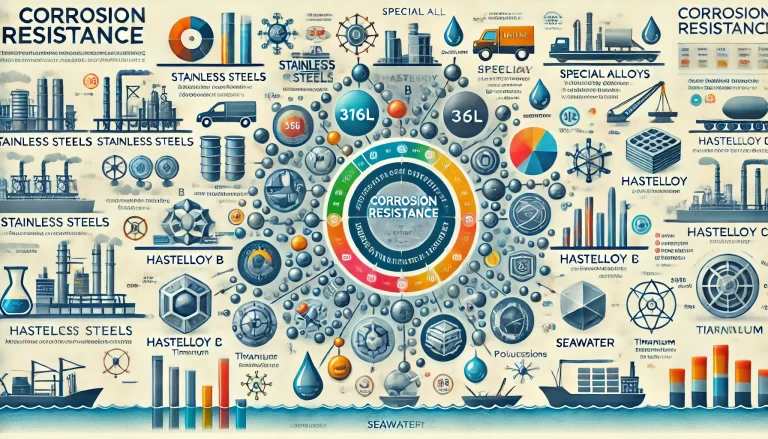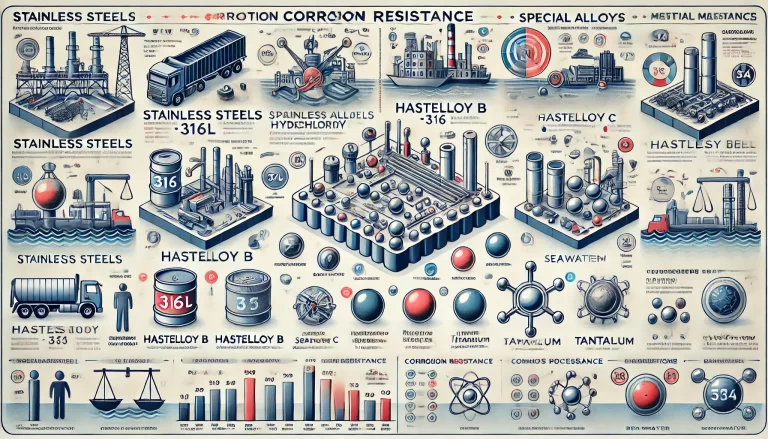1. Introduction
The selection of materials with excellent corrosion resistance is critical in various industries such as petrochemicals, fertilizers, and marine applications. This document provides a comprehensive overview of the corrosion resistance characteristics of different materials, including stainless steels, special alloys, and linings, under varying environmental conditions.
2. Corrosion Resistance of Common Metals and Alloys
2.1 Molybdenum-containing Stainless Steel (316L)
316L stainless steel (00Cr17Ni14Mo2) offers strong corrosion resistance in various environments, such as:
- Nitric acid, diluted sulfuric acid (<5%) at room temperature, boiling phosphoric acid, and formic acid.
- Alkaline solutions and seawater under specific pressure conditions.
- Acetic acid and other weak acids and bases.
Applications:
- Widely used in the petrochemical industry, urea production, and synthetic fiber manufacturing.
Limitations:
- Not suitable for use in hydrofluoric acid, wet chlorine gas, hydrochloric acid vapor, and halogens such as iodine and bromine.

2.2 Hastelloy B (HB Alloy)
Hastelloy B provides excellent corrosion resistance to:
- Hydrochloric acid at all concentrations below boiling points.
- Non-oxidizing acids such as sulfuric, phosphoric, hydrofluoric, and organic acids.
- Alkali solutions and non-oxidizing salt solutions.
Applications:
- Suitable for use in chemical processing plants and pharmaceutical industries.
2.3 Hastelloy C (HC Alloy)
Hastelloy C is highly resistant to oxidizing acids, such as:
- Nitric acid, mixed acids, and mixtures of chromic and sulfuric acids.
- Oxidizing salts such as Fe+++ and Cu++ ions.
- Corrosion from high-temperature hypochlorite solutions and seawater.
Applications:
- Ideal for chemical production processes that require high resistance to aggressive oxidizing media.
2.4 Titanium (Ti)
Titanium demonstrates exceptional resistance to:
- Seawater, chlorides, and hypochlorites.
- Oxidizing acids (e.g., fuming nitric acid) and organic acids.
- Alkaline environments.
Limitations:
- It does not perform well in pure reducing acids such as sulfuric and hydrochloric acids unless fluorides are present.
Applications:
- Extensively used in marine environments, desalination plants, and the aerospace industry.
2.5 Tantalum (Ta)
Tantalum offers outstanding corrosion resistance similar to glass, resisting almost all chemical media except:
- Hydrofluoric acid.
- Fuming sulfuric acid.
- Strong alkalis at elevated temperatures.
Applications:
- Frequently used in high-performance chemical reactors and heat exchangers.

3. Selection of Lining Materials
To enhance corrosion resistance, different lining materials can be selected based on the medium and temperature conditions.
3.1 Neoprene (Chloroprene Rubber)
- Excellent abrasion resistance with high elasticity and tensile strength.
- Suitable for general water, wastewater, and low-concentration acid environments.
- Maximum operating temperature: 80°C.
Applications:
- Ideal for slurry and salt solutions in industrial processing.
3.2 Polyurethane Rubber
- Superior wear resistance but slightly lower acid and alkali resistance.
- Suitable for neutral abrasive environments such as coal slurries and mining applications.
- Maximum operating temperature: 60°C.
3.3 Polytetrafluoroethylene (PTFE)
- Exceptional chemical stability, resisting strong acids such as hydrochloric acid, sulfuric acid, nitric acid, and aqua regia.
- Resistant to strong alkaline solutions and high temperatures up to 180°C, but not suitable for trifluorochlorine or difluorooxygen.
Applications:
- Used in the pharmaceutical and chemical processing sectors for highly corrosive substances.
3.4 F46 Fluoroplastic
- Similar properties to PTFE with enhanced tensile strength, aging resistance, and bonding capabilities.
- Performs well under strong oxidizing environments and high temperatures.
- Ideal for health-related applications due to its low friction and non-stick properties.
4. Corrosion Resistance Performance of Metallic Materials
4.1 Summary of Common Alloys and Pure Metals
The table below summarizes the corrosion resistance of frequently used alloys and metals in various environments:
| Material | Corrosion Resistance Characteristics | Limitations |
|---|---|---|
| 316L Stainless Steel | Excellent resistance to sulfuric acid, organic acids, and phosphoric acid. | Not suitable for halogens and hydrofluoric acid. |
| Monel Alloy | Highly resistant to hydrofluoric acid, seawater, and alkaline environments. | Poor resistance to nitric and sulfuric acid. |
| Hastelloy C276 | Exceptional resistance to oxidizing acids and chlorides. | Moderate resistance to hot concentrated acids. |
| Nickel | Stable in alkaline environments. | Corrodes in inorganic acids like sulfuric acid. |
| Titanium | Excellent resistance to seawater and chlorides. | Poor performance in pure reducing acids. |
| Tantalum | Outstanding overall resistance to most acids and oxidizing media. | Not resistant to hydrofluoric acid and strong alkalis. |
5. Corrosion Resistance Reference Guide
The following table provides a reference for material selection based on chemical media, concentration, and operating temperature:
| Medium | Concentration (%) | Temperature | Carbon Steel | 316 Steel | Hastelloy C | Monel | Tantalum | Titanium |
|---|---|---|---|---|---|---|---|---|
| Hydrochloric Acid | 5-10 | RT – BP | ○ | ● | ● | ● | ● | ● |
| Sulfuric Acid | 5-80 | RT – BP | ○ | ● | ● | ● | ● | ● |
| Nitric Acid | 10-70 | RT – BP | ○ | ● | ● | ● | ● | ● |
| Acetic Acid | 100 | RT – BP | ○ | ● | ● | ● | ● | ● |
Legend:
- ● Excellent resistance
- ○ Moderate resistance
- △ Poor resistance
Abbreviations:
- RT = Room Temperature
- BP = Boiling Point
6. Conclusion
The selection of corrosion-resistant materials requires careful consideration of the operating environment, chemical exposure, and temperature conditions. The information provided here serves as a guide to help choose suitable materials to enhance the longevity and efficiency of industrial applications.
